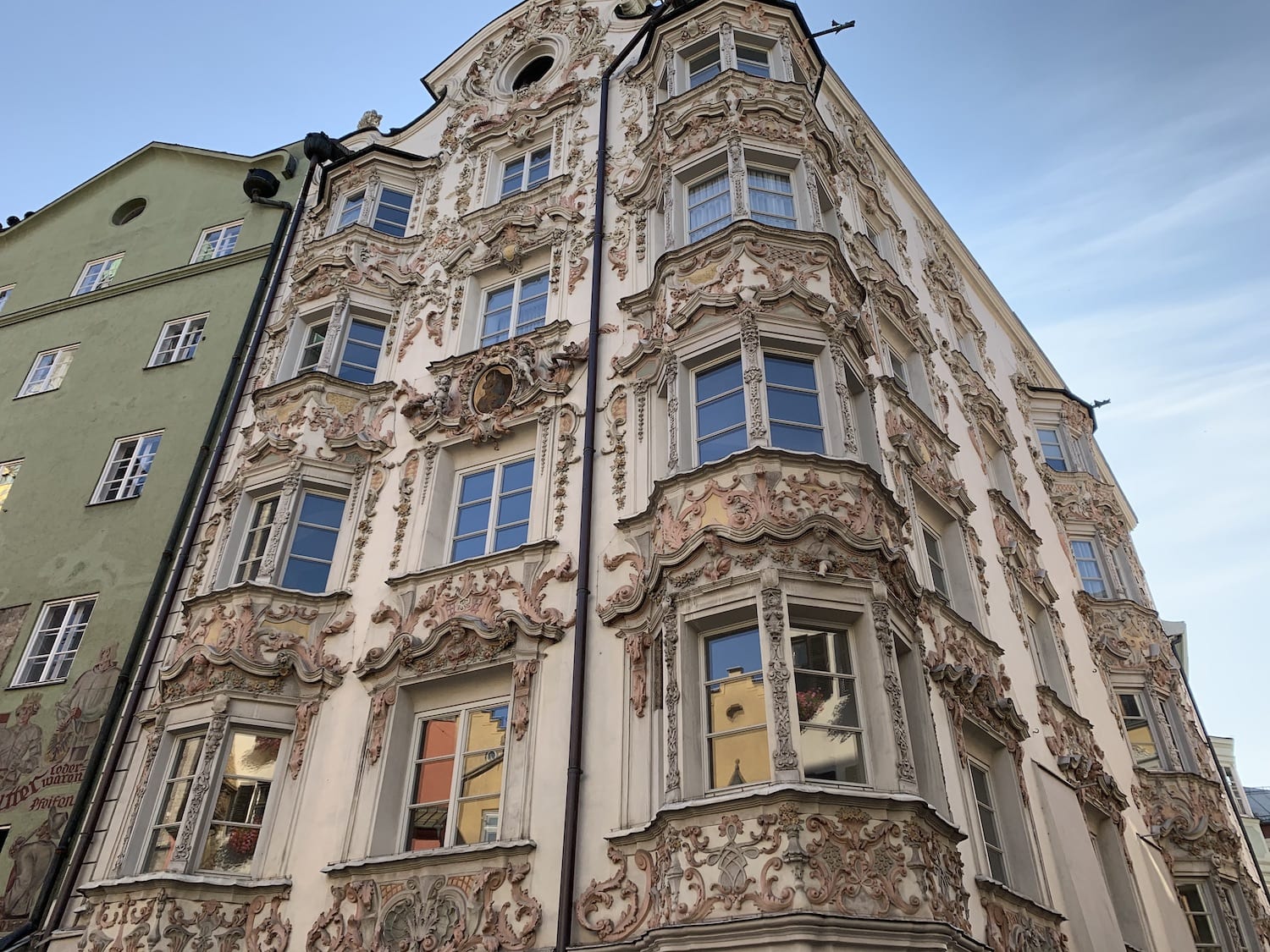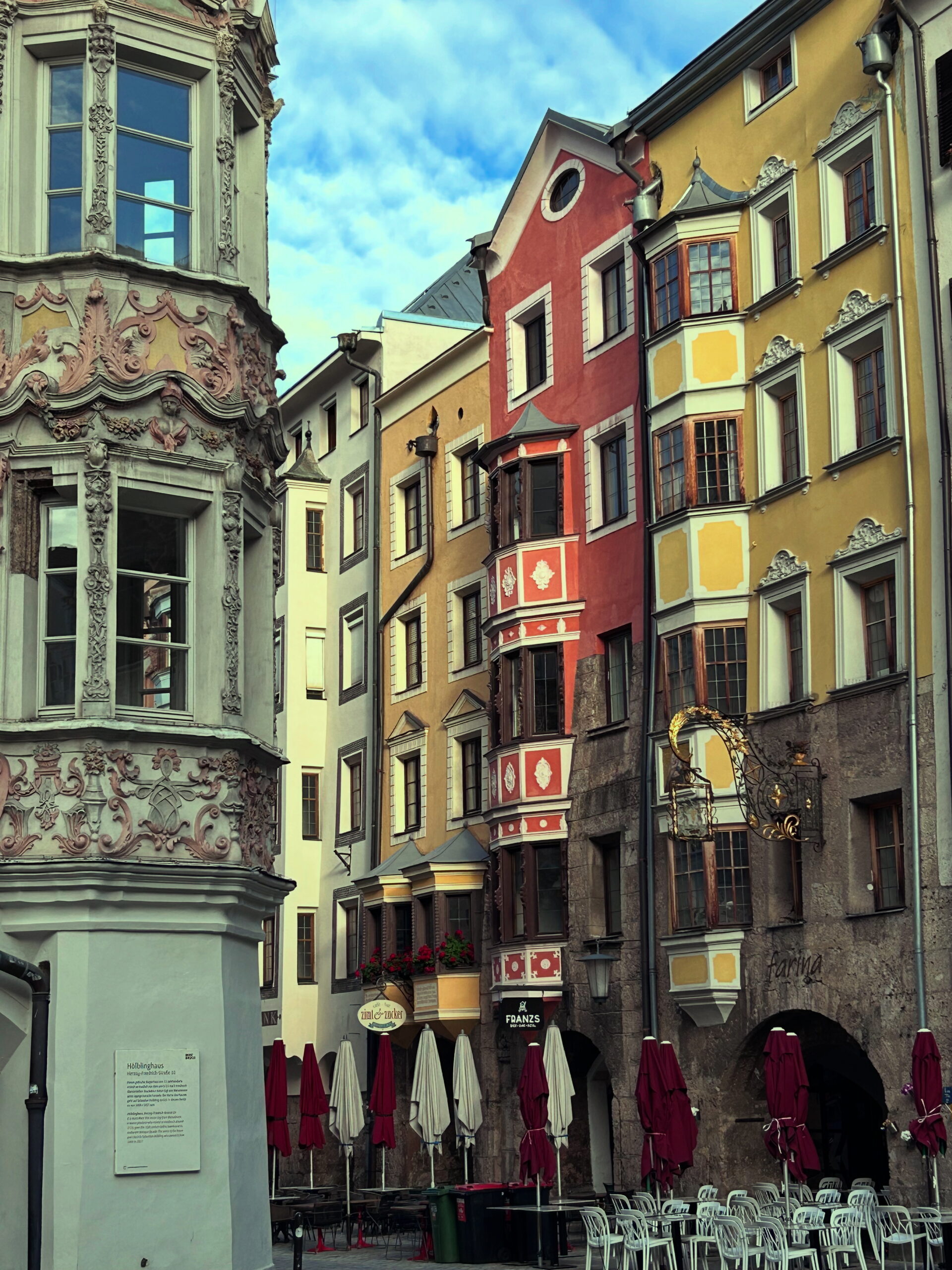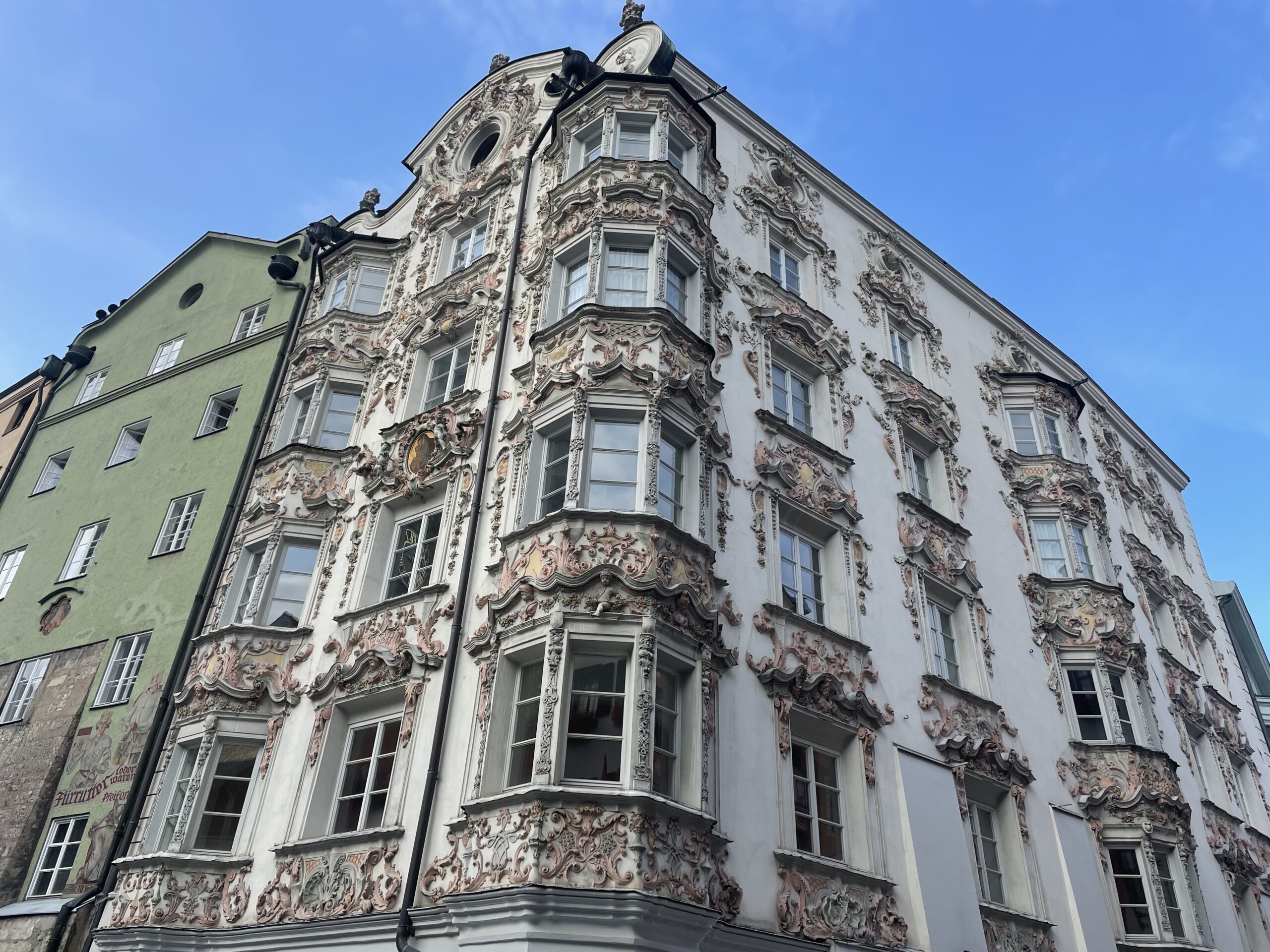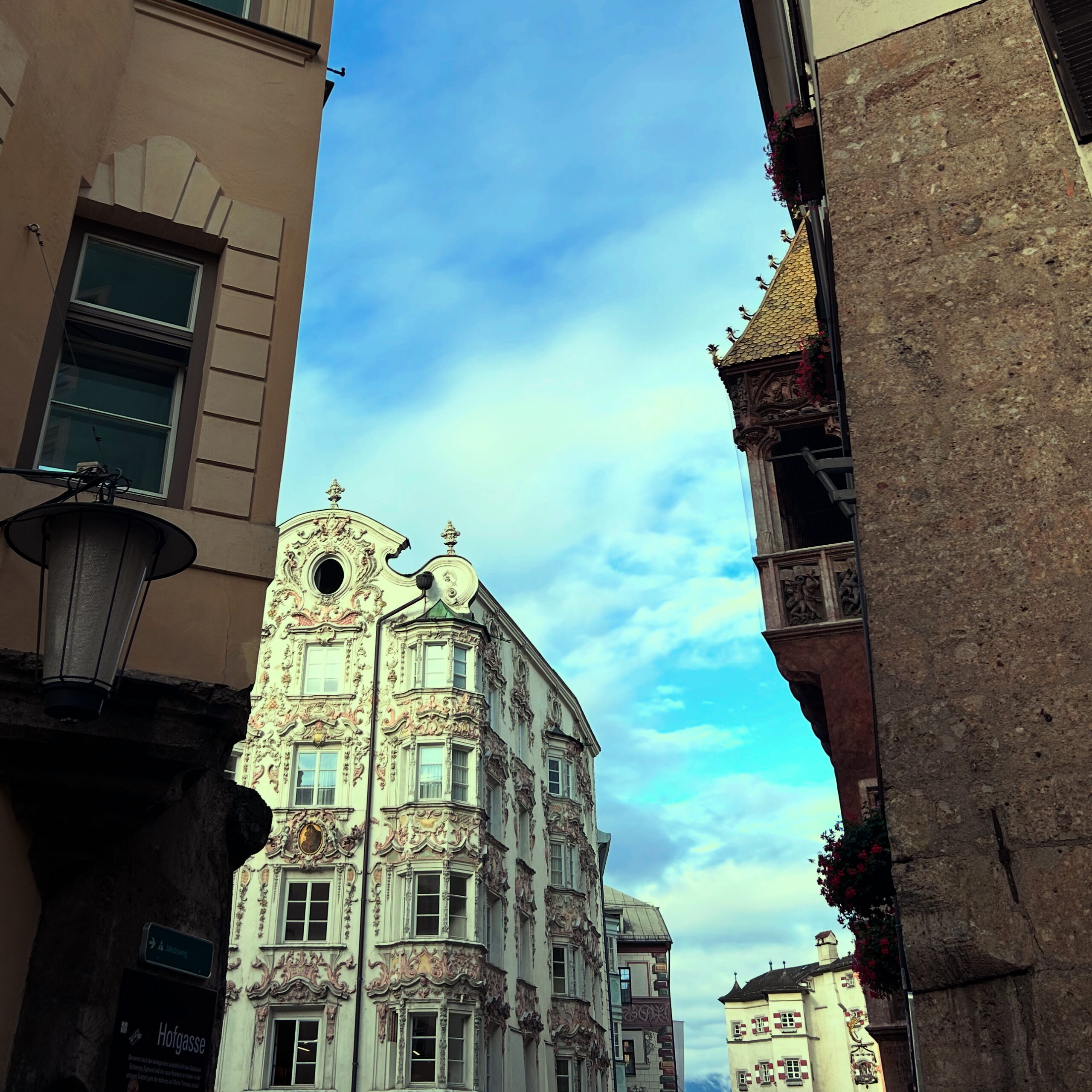Helblinghaus
Herzog-Friedrich-Straße 10
Worth knowing
The Helblinghaus is often described as the most beautiful building in Innsbruck. Purists, however, would call the only Baroque building among the Gothic houses misplaced and even kitschy. While tastes differ, one can objectively state that the richly stuccoed townhouse is a real eye-catcher. In 1730, Anton Gigl planned the conversion of a Gothic residential house into a building in the typical early 18th-century style for owner Johann Fischer. The Rococo façade features natural motifs, putti, masks, and other decorative elements. On the gable, in keeping with the spirit of the time, is a copy of Lucas Cranach’s devotional image Mariahilf. Less conspicuous but equally interesting is the very early depiction of a bare-breasted female figure. The 18th century in Tyrol was not an era when women’s bodies were commonly shown in their natural form in public. In other respects, too, the Helblinghaus was ahead of its time. The building got its name from its owner Sebastian Helbling, who, in the early 19th century, was one of the first in Innsbruck to serve the new trendy drink—coffee. At the beginning of the 20th century, the house hosted a Catholic Casino. This was not a gambling establishment but rather the meeting place of Innsbruck’s Casino Movement, a conservative political faction founded during the revolutionary year of 1848. Over the decades, the movement split into several branches, including one in the Habsburg Empire, which had not been part of the German Confederation since 1867. The Innsbruck branch consisted of academics and clerics close to the Church. The association opposed the liberal German People’s Party, which dominated the city council until World War I, and the Social Democrats. While they agreed that the German population was superior to other nationalities in the multinational Danube Monarchy, they found little else in common. Unlike the liberals, who envisioned modern, secular nation-states, the Casino Movement wanted to maintain the status quo in political and social life. Many of its members were Jesuits or had been educated under the order’s guidance. Keeping schools and education under the Church’s control was naturally a major concern for them. In the late days of the monarchy, the movement opposed universal suffrage, which the Social Democrats sought to introduce. Gender equality was equally anathema to them. Whether the depiction of the bare-breasted lady hastened the conservatives’ move to another base is not recorded. Today, the Helblinghaus houses shops and offices.
Maria help Innsbruck!
The veneration of saints and popular piety always walked a fine line between faith, superstition and magic. In the Alps, where people were more exposed to the almost inexplicable environment than in other regions, this form of faith took on remarkable and often bizarre forms. Saints were invoked for help with various everyday tasks. St Anne was supposed to protect the house and hearth, while St Notburga of Rattenberg, who was particularly popular in Tyrol, was prayed to for a good harvest. When fertilisers and agricultural machinery were increasingly used for this purpose, she rose to become the patron saint of women wearing traditional costumes. Miners entrusted their fate in their dangerous job underground to St Barbara and St Bernard. The chapel at the manor houses in Halltal near Innsbruck provides a fascinating insight into the world of faith between Begging spirit and worship of various local patron saints. The saint who still outshines all others in terms of veneration is Mary. From the consecration of herbs at the Assumption of Mary to the right-turning water in Maria Waldrast at the foot of the Serles and votive images in churches and chapels, she is a favourite permanent guest in popular piety. If you take a careful stroll through Innsbruck, you will find a special image on the facades of buildings time and again: the Gnadenbild Mariahilf by Lucas Cranach (ca. 1472 - 1553).
Cranach's Madonna is one of the most popular and most frequently copied depictions of Mary in the Alpine region. The painting is a reinterpretation of the classic iconographic Mother of God. Similar to the Mona Lisa da Vinci, which was painted at a similar time, Mary smiles mischievously at the viewer. Cranach dispensed with any form of sacralisation such as a crescent moon or halo and has her appear in contemporary everyday clothing. The red-blonde hair of mother and child transports her from Palestine to Europe. The saint and virgin Mary became an ordinary woman with a child from the upper middle class of the 16th century.
The creation, journey and veneration of the Mariahilf miraculous image tell the story of the Reformation, Counter-Reformation and popular piety in the German lands in miniature. The odyssey of the painting, which measures just 78 x 47 cm, began in what is now Thuringia at the royal court, one of the cultural centres of Europe at the time. Elector Frederick III of Saxony (1463 - 1525) was a pious man. He owned one of the most extensive collections of relics of the time. Despite his deep roots in the popular belief in relics and his pronounced penchant for Marian devotion, he supported Martin Luther in 1518 not only for religious reasons, but also for reasons of power politics. Free passage from the powerful prince and accommodation at Wartburg Castle enabled Luther to work on the German translation of the Holy Scriptures and his vision of a new, reformed church.
As was customary at the time, Friedrich also had a Art Director in his entourage. Lucas Cranach had been a court painter in Wittenberg since 1515. Like other painters of his time, Cranach was not only extremely productive, but also extremely enterprising. In addition to his artistic activities, he ran a pharmacy and a wine tavern in Wittenberg. Thanks to his financial prosperity and reputation, he was mayor of the town from 1528. Cranach was regarded as a quick painter with great output. He recognised art as a medium for capturing and disseminating the spirit of the times. Like Albrecht Dürer, he created popular works with a wide reach. His portraits of the high society of the time still characterise our image of celebrities today, such as those of his employer Frederick, Maximilian I, Martin Luther and his colleague Dürer.
Cranach and the church critics Philipp Melanchthon and Martin Luther met at Wittenberg Castle. It was through this acquaintance at the latest that the artist became a supporter of the new, reformed Christianity, which did not yet have an official manifestation. The ambiguities in the religious beliefs and practices of this period before the official schism are reflected in Cranach's works. Despite Luther and Melanchthon's rejection of the veneration of saints, the cult of the Virgin Mary and iconographic representations in churches, Cranach continued to paint for his patrons according to their taste.
Just as unclear as the transition from one denomination to another in the 16th century is the date of origin of the The miraculous image of Mariahilf. Cranach painted it sometime between 1510 and 1537 either for the household of Frederick's sister-in-law, Duchess Barbara of Saxony, or for the Church of the Holy Cross in Dresden. Art experts are still divided today. The friendship between Cranach and Martin Luther suggests that Cranach painted it after his conversion to Lutheranism and that this secularised depiction of a mother and child is an expression of a new religious world view. However, it is entirely possible that the business-minded artist painted the picture without any ideological background, but as an expression of the fashion of the time even before Luther's arrival in Wittenberg.
After Frederick's death, Cranach entered the service of his successor, John Frederick I of Saxony. When his employer was taken prisoner by the emperor after the Battle of Mühlberg in 1547, court painter Cranach followed him to Augsburg and Innsbruck despite his advanced age. After five years in the wake of the hostage, who was probably housed in luxury, Cranach returned to Wittenberg, where he succumbed to his biblical age by the standards of the time.
The Gnadenbild Mariahilf was transferred to the Kunstkammer of the Saxon sovereign during the turbulent years of the confessional wars, probably to save it from destruction by zealous iconoclasts. Almost 65 years later, like its creator before it, it was to find its way to Innsbruck along winding paths. When the art-loving Bishop of Passau from the House of Habsburg was a guest at court in Dresden in 1611, he chose Cranach's miraculous painting as a gift and took it with him to his prince-bishop's residence on the Danube. His cathedral dean saw it there and was so impressed that he had a copy made for his home altar. A pilgrimage cult quickly developed around the picture.
When the Bishop of Passau became Archduke Leopold V of Austria and Prince of Tyrol seven years later, the popular painting moved with its owner to the court in Innsbruck. His Tuscan wife Claudia de Medici kept the cult of the Virgin Mary in the Italian tradition alive even after his death. Both the Servite Church and the Capuchin monastery were given altars and images of the Virgin Mary. However, nothing was more popular than Cranach's miraculous image. In order to protect the city during the Thirty Years' War, the image was often taken from the court chapel and displayed for public veneration. During these mass prayers, the desperate population of Innsbruck shouted a loud "Maria Hilf" ("Mary Help") at the small painting, a practice that had become part of popular belief thanks to the Jesuits. In 1647, at the moment of greatest need, the Tyrolean estates swore to build a church around the painting to protect the country from devastation by Bavarian and Swedish troops. The fact that the reformed depiction of St Mary, painted by a friend of Martin Luther, was invoked to protect the city from Protestant troops is probably not without a certain irony.
Although the Mariahilf church was built, the painting was exhibited in 1650 in the parish church of St Jakob within the safe city walls. The newly built church received a copy made by Michael Waldmann. It was not to be the last of its kind. The motif and Cranach's depiction of the Mother of God became extremely popular and can still be found today not only in churches but also on countless private houses. Art became a mass phenomenon through these copies. The image of the Virgin Mary had migrated from the private property of the Saxon prince to the public sphere. Centuries before Andy Warhol and Roy Lichtenstein, Cranach and Dürer had become widely copied artists and their paintings had become part of public space and everyday life. The original of the The miraculous image of Mariahilf may hang in St Jacob's Cathedral, but the copy and the parish that grew up around it gave its name to an entire district.
Baroque: art movement and art of living
Anyone travelling in Austria will be familiar with the domes and onion domes of churches in villages and towns. This form of church tower originated during the Counter-Reformation and is a typical feature of the Baroque architectural style. They are also predominant in Innsbruck's cityscape. Innsbruck's most famous places of worship, such as the cathedral, St John's Church and the Jesuit Church, are in the Baroque style. Places of worship were meant to be magnificent and splendid, a symbol of the victory of true faith. Religiousness was reflected in art and culture: grand drama, pathos, suffering, splendour and glory combined to create the Baroque style, which had a lasting impact on the entire Catholic-oriented sphere of influence of the Habsburgs and their allies between Spain and Hungary.
The cityscape of Innsbruck changed enormously. The Gumpps and Johann Georg Fischer as master builders as well as Franz Altmutter's paintings have had a lasting impact on Innsbruck to this day. The Old Country House in the historic city centre, the New Country House in Maria-Theresien-Straße, the countless palazzi, paintings, figures - the Baroque was the style-defining element of the House of Habsburg in the 17th and 18th centuries and became an integral part of everyday life. The bourgeoisie did not want to be inferior to the nobles and princes and had their private houses built in the Baroque style. Pictures of saints, depictions of the Mother of God and the heart of Jesus adorned farmhouses.
Baroque was not just an architectural style, it was an attitude to life that began after the end of the Thirty Years' War. The Turkish threat from the east, which culminated in the two sieges of Vienna, determined the foreign policy of the empire, while the Reformation dominated domestic politics. Baroque culture was a central element of Catholicism and its political representation in public, the counter-model to Calvin's and Luther's brittle and austere approach to life. Holidays with a Christian background were introduced to brighten up people's everyday lives. Architecture, music and painting were rich, opulent and lavish. In theatres such as the Comedihaus dramas with a religious background were performed in Innsbruck. Stations of the cross with chapels and depictions of the crucified Jesus dotted the landscape. Popular piety in the form of pilgrimages and the veneration of the Virgin Mary and saints found its way into everyday church life. Multiple crises characterised people's everyday lives. In addition to war and famine, the plague broke out particularly frequently in the 17th century. The Baroque piety was also used to educate the subjects. Even though the sale of indulgences was no longer a common practice in the Catholic Church after the 16th century, there was still a lively concept of heaven and hell. Through a virtuous life, i.e. a life in accordance with Catholic values and good behaviour as a subject towards the divine order, one could come a big step closer to paradise. The so-called Christian edification literature was popular among the population after the school reformation of the 18th century and showed how life should be lived. The suffering of the crucified Christ for humanity was seen as a symbol of the hardship of the subjects on earth within the feudal system. People used votive images to ask for help in difficult times or to thank the Mother of God for dangers and illnesses they had overcome.
The historian Ernst Hanisch described the Baroque and the influence it had on the Austrian way of life as follows:
„Österreich entstand in seiner modernen Form als Kreuzzugsimperialismus gegen die Türken und im Inneren gegen die Reformatoren. Das brachte Bürokratie und Militär, im Äußeren aber Multiethnien. Staat und Kirche probierten den intimen Lebensbereich der Bürger zu kontrollieren. Jeder musste sich durch den Beichtstuhl reformieren, die Sexualität wurde eingeschränkt, die normengerechte Sexualität wurden erzwungen. Menschen wurden systematisch zum Heucheln angeleitet.“
The rituals and submissive behaviour towards the authorities left their mark on everyday culture, which still distinguishes Catholic countries such as Austria and Italy from Protestant regions such as Germany, England or Scandinavia. The Austrians' passion for academic titles has its origins in the Baroque hierarchies. The expression Baroque prince describes a particularly patriarchal and patronising politician who knows how to charm his audience with grand gestures. While political objectivity is valued in Germany, the style of Austrian politicians is theatrical, in keeping with the Austrian bon mot of "Schaumamal".
Wilhelm Greil: DER Bürgermeister Innsbrucks
One of the most important figures in the town's history was Wilhelm Greil (1850 - 1923). From 1896 to 1923, the entrepreneur held the office of mayor, having previously helped to shape the city's fortunes as deputy mayor. It was a time of growth, the incorporation of entire neighbourhoods, technical innovations and new media. The four decades between the economic crisis of 1873 and the First World War were characterised by unprecedented economic growth and rapid modernisation. Private investment in infrastructure such as railways, energy and electricity was desired by the state and favoured by tax breaks in order to lead the countries and cities of the ailing Danube monarchy into the modern age. The city's economy boomed. Businesses sprang up in the new districts of Pradl and Wilten, attracting workers. Tourism also brought fresh capital into the city. At the same time, however, the concentration of people in a confined space under sometimes precarious hygiene conditions also brought problems. The outskirts of the city and the neighbouring villages in particular were regularly plagued by typhus.
Innsbruck city politics, in which Greil was active, was characterised by the struggle between liberal and conservative forces. Greil belonged to the "Deutschen Volkspartei", a liberal and national-Great German party. What appears to be a contradiction today, liberal and national, was a politically common and well-functioning pair of ideas in the 19th century. The Pan-Germanism was not a political peculiarity of a radical right-wing minority, but rather a centrist trend, particularly in German-speaking cities in the Reich, which was significant in various forms across almost all parties until after the Second World War. Innsbruckers who were self-respecting did not describe themselves as Austrians, but as Germans. Those who were members of the liberal Innsbrucker Nachrichten of the period around the turn of the century, you will find countless articles in which the common ground between the German Empire and the German-speaking countries was made the topic of the day, while distancing themselves from other ethnic groups within the multinational Habsburg Empire. Greil was a skilful politician who operated within the predetermined power structures of his time. He knew how to skilfully manoeuvre around the traditional powers, the monarchy and the clergy and to come to terms with them.
Taxes, social policy, education, housing and the design of public spaces were discussed with passion and fervour. Due to an electoral system based on voting rights via property classes, only around 10% of the entire population of Innsbruck were able to go to the ballot box. Women were excluded as a matter of principle. Relative suffrage applied within the three electoral bodies, which meant as much as: The winner takes it all. Greil wohne passenderweise ähnlich wie ein Renaissancefürst. Er entstammte der großbürgerlichen Upper Class. Sein Vater konnte es sich leisten, im Palais Lodron in der Maria-Theresienstraße die Homebase der Familie zu gründen. Massenparteien wie die Sozialdemokratie konnten sich bis zur Wahlrechtsreform der Ersten Republik nicht durchsetzen. Konservative hatten es in Innsbruck auf Grund der Bevölkerungszusammensetzung, besonders bis zur Eingemeindung von Wilten und Pradl, ebenfalls schwer. Bürgermeister Greil konnte auf 100% Rückhalt im Gemeinderat bauen, was die Entscheidungsfindung und Lenkung natürlich erheblich vereinfachte. Bei aller Effizienz, die Innsbrucker Bürgermeister bei oberflächlicher Betrachtung an den Tag legten, sollte man nicht vergessen, dass das nur möglich war, weil sie als Teil einer Elite aus Unternehmern, Handelstreibenden und Freiberuflern ohne nennenswerte Opposition und Rücksichtnahme auf andere Bevölkerungsgruppen wie Arbeitern, Handwerkern und Angestellten in einer Art gewählten Diktatur durchregierten. Das Reichsgemeindegesetz von 1862 verlieh Städten wie Innsbruck und damit den Bürgermeistern größere Befugnisse. Es verwundert kaum, dass die Amtskette, die Greil zu seinem 60. Geburtstag von seinen Kollegen im Gemeinderat verliehen bekam, den Ordensketten des alten Adels erstaunlich ähnelte.
Under Greil's aegis and the general economic upturn, fuelled by private investment, Innsbruck expanded at a rapid pace. In true merchant style, the municipal council purchased land with foresight in order to enable the city to innovate. The politician Greil was able to rely on the civil servants and town planners Eduard Klingler, Jakob Albert and Theodor Prachensky for the major building projects of the time. Infrastructure projects such as the new town hall in Maria-Theresienstraße in 1897, the opening of the Mittelgebirgsbahn railway, the Hungerburgbahn and the Karwendelbahn wurden während seiner Regierungszeit umgesetzt. Weitere gut sichtbare Meilensteine waren die Erneuerung des Marktplatzes und der Bau der Markthalle. Neben den prestigeträchtigen Großprojekten entstanden in den letzten Jahrzehnten des 19. Jahrhunderts aber viele unauffällige Revolutionen. Vieles, was in der zweiten Hälfte des 19. Jahrhunderts vorangetrieben wurde, gehört heute zum Alltag. Für die Menschen dieser Zeit waren diese Dinge aber eine echte Sensation und lebensverändernd. Bereits Greils Vorgänger Bürgermeister Heinrich Falk (1840 – 1917) hatte erheblich zur Modernisierung der Stadt und zur Besiedelung des Saggen beigetragen. Seit 1859 war die Beleuchtung der Stadt mit Gasrohrleitungen stetig vorangeschritten. Mit dem Wachstum der Stadt und der Modernisierung wurden die Senkgruben, die in Hinterhöfen der Häuser als Abort dienten und nach Entleerung an umliegende Landwirte als Dünger verkauft wurden, zu einer Unzumutbarkeit für immer mehr Menschen. 1880 wurde das RaggingThe city was responsible for the emptying of the lavatories. Two pneumatic machines were to make the process at least a little more hygienic. Between 1887 and 1891, Innsbruck was equipped with a modern high-pressure water pipeline, which could also be used to supply fresh water to flats on higher floors. For those who could afford it, this was the first opportunity to install a flush toilet in their own home.
Greil continued this campaign of modernisation. After decades of discussions, the construction of a modern alluvial sewerage system began in 1903. Starting in the city centre, more and more districts were connected to this now commonplace luxury. By 1908, only the Koatlackler Mariahilf und St. Nikolaus nicht an das Kanalsystem angeschlossen. Auch der neue Schlachthof im Saggen erhöhte Hygiene und Sauberkeit in der Stadt. Schlecht kontrollierte Hofschlachtungen gehörten mit wenigen Ausnahmen der Vergangenheit an. Das Vieh kam im Zug am Sillspitz an und wurde in der modernen Anlage fachgerecht geschlachtet. Greil überführte auch das Gaswerk in Pradl und das Elektrizitätswerk in Mühlau in städtischen Besitz. Die Straßenbeleuchtung wurde im 20. Jahrhundert von den Gaslaternen auf elektrisches Licht umgestellt. 1888 übersiedelte das Krankenhaus von der Maria-Theresienstraße an seinen heutigen Standort. Bürgermeister und Gemeinderat konnten sich bei dieser Innsbrucker Renaissance neben der wachsenden Wirtschaftskraft in der Vorkriegszeit auch auf Mäzen aus dem Bürgertum stützen. Waren technische Neuerungen und Infrastruktur Sache der Liberalen, verblieb die Fürsorge der Ärmsten weiterhin bei klerikal gesinnten Kräften, wenn auch nicht mehr bei der Kirche selbst. Freiherr Johann von Sieberer stiftete das Greisenasyl und das Waisenhaus im Saggen. Leonhard Lang stiftete das Gebäude in der Maria-Theresienstraße, in der sich bis heute das Rathaus befindet gegen das Versprechen der Stadt ein Lehrlingsheim zu bauen.
Im Gegensatz zur boomenden Vorkriegsära war die Zeit nach 1914 vom Krisenmanagement geprägt. In seinen letzten Amtsjahren begleitete Greil Innsbruck am Übergang von der Habsburgermonarchie zur Republik durch Jahre, die vor allem durch Hunger, Elend, Mittelknappheit und Unsicherheit geprägt waren. Er war 68 Jahre alt, als italienische Truppen nach dem Ersten Weltkrieg die Stadt besetzten und Tirol am Brenner geteilt wurde. Das Ende der Monarchie und des Zensuswahlrechts bedeuteten auch den Niedergang der Liberalen in Innsbruck, auch wenn Greil das in seiner aktiven Karriere nur teilweise miterlebte. 1919 konnten die Sozialdemokraten in Innsbruck zwar zum ersten Mal den Wahlsieg davontragen, dank der Mehrheiten im Gemeinderat blieb Greil aber Bürgermeister. 1928 verstarb er als Ehrenbürger der Stadt Innsbruck im Alter von 78 Jahren. Die Wilhelm-Greil-Straße war noch zu seinen Lebzeiten nach ihm benannt worden.




